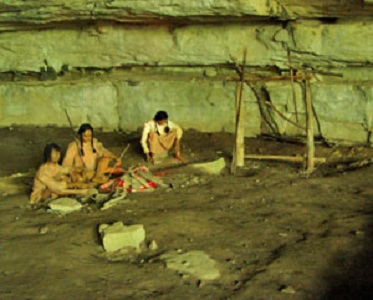
Courtesy National Park Service (Christopher Light)
The cave and associated burial sites and shelters are all the more remarkable, because the occupation and use of the area was regular, providing a chronological layering of artifacts from before recorded history to the modern era. Created when part of the cave collapsed, the shelter inside the cave is roughly 30 by 65 yards and has a streambed that forms part of the cave floor. Attracted by a year-round water source and the consistent temperature inside the cave, many American Indian groups regularly used Russell Cave as a seasonal dwelling place. The cave is located in a valley along the Tennessee River, which helped supply the cave occupants with shellfish and game. Given the location of the cave within the valley, it is probable that the entire area was a hunting ground even before the formation of the cave. As American Indian groups discovered the cave, and camped and lived in it, they found food and raw materials to develop tools on the land around it. They also used the surrounding land for religious ceremonies, including burial of the dead. More recently, this land was the possible site of a log cabin as well as two historic coalmines and associated structures.
Paleoindian peoples, the first humans in North America, were the first group to use Russell Cave. Artifacts from this period tend to be projectile points formed of stone quarried nearby and sharpened into points inside the cave. The majority of objects found at Russell Cave, though, come from three later archeological stages: the Archaic Stage (7000 to 500 BC), the Woodland Stage (500 BC to 1000 AD), and the Mississippian Stage (1000 to 1600 AD). While Archaic dwellers were sedentary hunters and gatherers with few social divisions, the material culture of the Woodland period indicates that larger populations supported the development of a social structure and widening trade networks. In general, people of the Mississippian Stage were very sedentary travelling less than previous groups and relying heavily on the cultivation of crops. They also had highly developed religious ceremonies and political structures. The artifacts recovered from Russell Cave reflect the technological and social changes typical for the Archaic, Woodland, and Mississippian Stages.
Given the long history of settlement of Russell Cave, the archeological material provides a level of depth uncommon at other sites. In both the cave and surrounding areas, the continued presence of humans has resulted in a collection of artifacts that almost trace the complete development of some technologies. The cave has yielded projectile points, fishhooks (7500 to 5000 BC and 3500 to 500 BC), basketry (7500 to 5000 BC), and ceramics (7500 BC to 1540 AD). Pottery shards date from the earliest ceramic pieces to those of the early 19th century, and some of the fishhooks are of a type not seen anywhere else. Outside the cave, in some of the outlying archeological areas, seed evidence remains of the maize and other crops cultivated as early as 500 BC.
Residency in the cave and use of the adjacent areas in religious ceremonies declined after about 1000 AD as the local populations, who had formerly used the cave as temporary seasonal shelter, developed permanent year-round villages. Following the arrival of the Europeans in the early 1500s, the use of the Russell Cave area practically ceased, as new settlers replaced American Indian groups. Artifacts from after the mid-1500s indicate that the cave saw only sporadic use as a hunting camp before becoming private property in 1817. The Russell family owned the cave at one point, giving the cave its name. The cave site represents the development of early culture and society and provides important evidence of how American Indians of the region lived for thousands of years.
Despite its eventual decline as a shelter, Russell Cave National Monument offers a unique opportunity to view the past in the present. Although the natural setting has changed slightly since 10,000 BC, the site of the cave itself has remained relatively unaltered. Today, the visitor center and museum present artifacts and reproductions of objects found in and around the cave as well as films about the earliest settlers in the region. Ranger-led cave tours allow visitors to explore the cave itself; other tours conducted by the rangers demonstrate pre-contact weaponry and tools. A visit to Russell Cave is a journey through the early settled history of the Americas presented not only through artifacts, but also through a tour of the very site where people have lived for thousands of years.
Russell Cave National Monument, a unit of the National Park System, is located just south of the Alabama-Tennessee border at 3729 County road 98 in Bridgeport, AL. Click here for the National Register of Historic Places registration file: text and photos. The park is closed on Thanksgiving, Christmas, and New Year’s Day but is otherwise open 8:00 am to 4:30pm CST. No fee is charged to visit the park, although reservations are requested for groups of 20 or more. For more information, visit the National Park Service Russell Cave National Monument website or call 256-495-2672. Reservations may be made by calling the number above. Park Rangers offer tours of the cave and weaponry demonstrations. Other park activities include hiking and birding.Last updated: August 8, 2017
